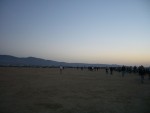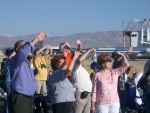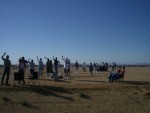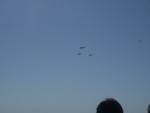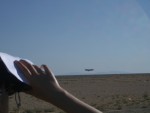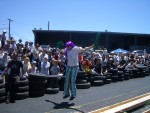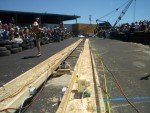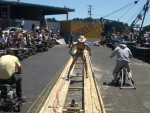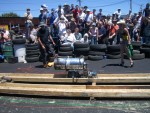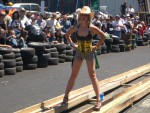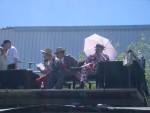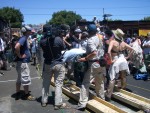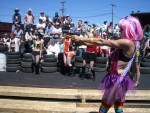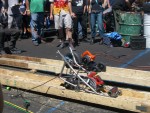June 22, 2004
SpaceShipOne
It was like being back in the 60s. Brian Slesinsky invited me to with him to see SpaceShipOne, the Paul Allen-funded private space program, and we went yesterday for the launch early this morning at the Mojave Airport.
The crowd was a mixture of NASCAR dads there for the tech, aerospace students and sci-fi geeks there to dream, retirees to relive their Cold War youth, and Libertarians to prove that anything the government can do, private industry can do better.
All of them got something from the experience. It was a fascinating mixture of gung-ho American free enterprise optimism (the announcers repeated that the biggest obstacle had not been technical, but convincing the FAA; other times they talked about how this was the start of a new era of California aerospace), nostalgia (Mike Melvill is a space cowboy cast from the classic mold), cool technology and a beer drinkin' good time (though the early-morning liftoff kept most of the beer drinking to the night before).
Political and cultural analysis aside, it was a tremendous event. The technical achievement is huge, and the presentation was organized like clockwork. The rocket's tiny contrail was nearly invisible against the sun. Everyone strained to see it, and when it finally appeared, it was breathtaking in its elegance and fragility (it must have lasted less than a minute). The next 20 minutes was so nervewracking, as everyone tried to catch sight of it, the announcers forgot to do any play-by-play. When it finally appeared, moving a lot faster than I thought any glider should move, chased by 4 planes, it was hard not to feel joy for the pure simplicity of the event, the meaningless act that means so much. I wouldn't have missed it.
June 14, 2004
Power Tool Drag Races, Day 2
So the second day of the Power Tool Drag Races was today. I wasn't able to stay through all of it, but I did get to run Power Pierce, my can opener-based vehicle, which was designed to go as slowly as possible. I figured that everyone was gunning for the top end of the standings, and no one was likely going for the low end intentionally, so it would be a wide open field. I registered in the Top Fuel category with the expectation that I had a decent chance that whoever I ran against would wipe out and that, tortoise-like, my can opener would eventually crawl to the finish line. Unfortunately, there was a mix-up and I didn't get to run in competition, but I did get an exhibition run.
Here are some photos:
June 13, 2004
Power Tool Drag Races, Day 1
Today I was fortunate enough to participate in the Power Tool Drag Races, one of the more ridiculous and fun San Francisco technology-art events. I pulled extension cords all afternoon in exchange for having a great view of the action. Tomorrow, the big race day, my vehicle races.
Here are some pictures. It clearly shares the Mad Max esthetic sensibilities with SRL and Burning Man (not surprisingly, the personnel overlap between the three organizations is high):
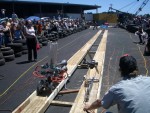
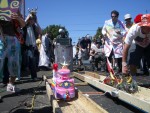
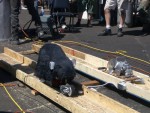
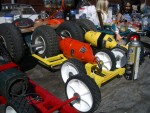
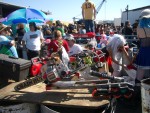
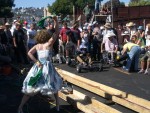
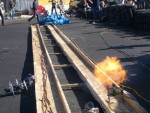
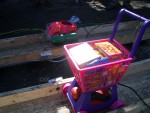
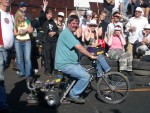
Niki de Saint-Phalle and Jean Tinguely would have been proud (they did the crazy, colorful fountain at the George Pompidou center in Paris and are probably the patron saints of all this stuff).
Here's an essay I wrote for Charlie Gadeken (of Qbox) last year, when he asked for a review of the 2003 event. It's a bit smug, but I think the description is still relevant.
A Carnival for Belt Sanders
There was a moment at this years' Power Tool Drag Races when one of the racers — a gas-powered saw thing with rubber tricycle wheels and a dented trombone for a muffler called Horned Devil — jumped the track. The wheels were probably designed to be big enough to keep the thing between the guide rails so that it wouldn't get turned sideways and drag itself to a halt, as some of the racers do. Nice idea, but that's not what happened. The problem was likely that the wheels were too big and had just enough grip on the rubber tread to grab the edge of one of the two-by-fours that make up the rails. This probably caused the other wheel, which was still on the ground, to push a little harder, turning the thing directly into the rail, which it proceeded to hop pretty effortlessly. Since the thing was gas-powered, the power couldn't be cut once it had left the starting line and it kept going in whatever direction it was last pointed at.So it made a beeline for the audience's legs. Ideally, the audience was supposed to keep their arms and legs behind a fence of old tires that separated them from the track. People, however, tend to take their mastery over technology for granted and the Power Tool Drag Race audience was as cavalier about it as their parents were on midway parachute rides and as their grandparents were when standing next to the big bull at the rodeo.
I was standing next to the track when the Horned Devil jumped the rails, and I could see the puzzled look on people's faces as the thing made for their legs. Having left their computers and cappuccino machines (who used which for work and which for entertainment is hard to tell in this crowd) and driven to Ace Auto Salvage in their electronic fuel injected cars and motorcycles, they at first seemed a bit surprised to see the thing coming at them. Sure they had to sign this waiver thing before going in, but that had been long forgotten in an afternoon of beer, sun and funny announcers. As their thoughts turned from "Cool! It's jumped the track!" to "Crap! It's going to eat my legs!" may be there was a moment of contemplation about our relationship with our domesticated technology, a shift in the attitude to the objects that surround us and which we take for granted.
I doubt it. In the seconds before a car crash no one reflects on their comfort zone in the balance between convenience and safety, and I doubt anyone was thinking of anything but getting their somewhat sunburned legs behind the tires. But it's kind of a nice thing to think about.
The funny thing about the Power Tool Drag Races is how little the racing mattered. Sure there were a lot of entries and there were all the trappings of a race (announcers, hot dogs, flag girls, stopwatches, a leader board, a bookie). Yes, toward evening Jim Mason's nitrogen fire extinguisher skateboard did 0-60 mph in about a second and beat out a hand drill on an RC car frame, weed whackers, circular saws, and the usual gang of sanders. As his grand prize, Jim now technically owns a semi-functional Edsel sedan. But that's not the point. Unlike the hardware store belt sander races for which basement tinkerers make their sanders a little faster every year to take out their neighbor in the parking lot of the local ACE and get a gift certificate and a trophy, this is different. In San Francisco it's not so much what you do, it's what you wear while you're doing it, and the drag race is no different. No one really complained that Jim was one of the founders of the race and that including fire extinguishers is kind of stretching the definition of power tools [nb: in 2004 they've changed the rules so that Jim's racer now fits in the rules and the RC car doesn't]. Only a few people seemed to bother trying to figure out how to get the most torque out of a leaf blower. It's unclear whether anyone even wanted to win the Edsel. Taken as a whole, the point wasn't the race, it was the drag.
And there was a lot of power tool drag. Freed from domestic drudgery, the power tools let their freak flags fly. From the Horned Devil to the belt sander slut thing to the Teddy Bears' Tragic Picnic to the thing that was only held together by jamming and wedging pieces to each other, it was an orgy of machine decoration, somewhere between performance and costume ball. Who knows what drove people to stick saws on skateboards and then spend days, weeks in some cases, futzing and decorating the things. What drives people to hang fuzzy dice from their rearview mirrors, to get silly cell phone faces. Why did kids stick cards in bike spokes and hang streamers from the handle bars? Maybe we want our machines to be a little more like us, so that we don't turn into them.
June 10, 2004
The Earth from above
I spend a lot of time looking out the window of airplanes and I rarely tire of it. A big fan of Ad Reinhardt, I like the monochrome look of the sky, the clouds and the earth, and the slight curve of the world below.
Here are some pictures I took my most recent trip from Michigan to Oakland, I like the chiaroscuro effect created by the scratched porthole glass:





June 08, 2004
Usability News on 2ad
2ad, the Second International Appliance Design Conference was one of the best conferences I've been to. Small (150 people, though it seemed even smaller than that), focused (one track, carefully sequenced), brave (they scheduled a robot soccer tournament in the middle of the thing!) and smart. I was really flattered when they accepted my proposal to do a side show for their Bazaar, similar to UPA's Idea Market (which, incidentally, I--uh--was supposed to talk at later this week, but unfortunately can't be at--it looks great, though). I really like the Idea Trade Show concept behind this, and it seemed to work particularly well at 2ad. In fact, Ann Light, of Usability News, has written an excellent roundup of how it went.
I don't know if it's just my brain pattern matching, but it seemed that key ideas of two of my favorite gatherings--Burning Man and the TED conferences--were incorporated in, of all things, a corporate research lab context. Burning Man is the mother of all performance bazaars and TED is the best idea theater in the world, and 2ad managed to capture some of the magic of both. Props to the organizers. I can't wait to go next year.
June 07, 2004
My phone=me
There are few things that are not part of our bodies that are as universally present with us as our phones. As Bluetooth beacons appear in our phones, this means that our phones are broadcasting identifiers of us. Ignoring the potential privacy problems with this (yes, ladies and gentlemen, if every database in the world was linked, bad people could find out information about us that we don't want them to know), the idea of having a broadcast identifier of us is really powerful.
In one version of their "Familiar Stranger" project Elizabeth Goodman and Eric Paulos use Bluetooth phone beacons to track the people who we have been in the same space with before, in order to identify the landscape of near-miss acquaintances in our lives.
In their "Personalized Shared Ubiquitous Devices" article in the May/June 2004 Interactions magazine David Hilbert and Jonathan Trevor of FXPAL discuss the idea of a "personal information cloud" which, like the "recent documents" menu, contains a list of recently used documents, but it's a list that's independent of an application or device:
For instance, editing a Word document on my desktop, or a PowerPoint presentation on my laptop, would populate my cloud with these documents. Furthermore, our clouds would become populated through the use of any computing device, including multi-function copiers [they are, after all, working for a copier-maker ;-) --mk]. So if I copied or scanned a document, it would appear in my cloud.
The way they have people access their information cloud is through the use of RFID cards and/or software running on PDAs.
Now, combine the idea of the Bluetooth identity beacon and the document cloud into a single office use scenario (for example) to create a smart hoteling cubicle (or work surface, for the cube-averse):
The cubicle recognizes who is in it who is in it by the Bluetooth beacon on their phone (rather than an RFID card or specialized software). The phone doesn't need to share any "real" information to the cubicle at all, just its unique id. As you walk into the cubicle, it brings up your personal photo archive on the digital picture frame, asks the PBX to forwards your extension to the local phone and brings up your desktop on the shared computer.
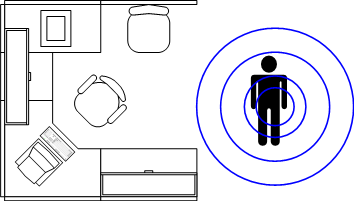
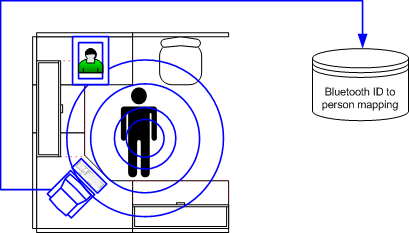
This is the trivial case. Now, imagine, two people in the cube together. I'm sitting at my desk and you walk in to chat. You're likely coming over to talk to me about something you're working on (let's assume). Since you're carrying your phone, the cube knows you're in the same space as me, so it gives my desktop computer instant access to your information cloud:
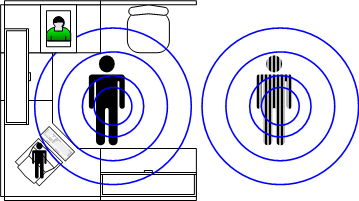
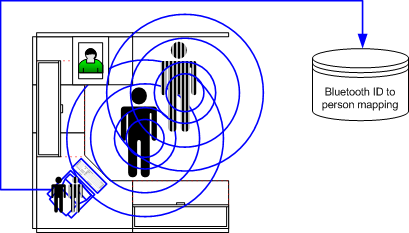
The next step from here is to keep a log of who was in your cube and when, mapped that information to a calendar, maybe along with the files you worked on together, and their most current versions.
Now let's move to a group work area--maybe a bullpen, lounge or conference room. Either a central computer (like described in the Interactions article) or a Bluetooth-enabled laptop can figure out who's in the general vicinity and create a folder called "People who are near me" that lists all of the information clouds of the people in my immediate vicinity, since we're likely going to need each others' files while working together. That way, not everyone need bring their laptops in order to be able to collaborate on a set of documents together.
Treating a Bluetooth-enabled phone as an identity marker, "my phone = me", we can start to ask a whole new set of questions about how identifying ourselves to our surroundings can affect the way we use those surroundings. Moreover, this is a technology that augments existing technologies and ways of work, rather than requiring new ways of working and new technologies to understand, and it does it passively. Even if the implications of losing your cell phone now become that much more dire, I think that's hot.
June 04, 2004
Toothpicks, logos and definition of design
I just finished reading John Heskett's Toothpicks & Logos: Design in Everyday Life. It's an interesting counterpart to Bill Stumpf's The Ice Palace That Melted Away: How Good Design Enhances Our Lives and Virginia Posterel's The Substance of Style (which I discuss here). All three books create a case for the importance of design.
Stumpf, one of the designers of the Aeron, writes an intimate personal description--almost an autobiography--of how design has shaped his world and why he thinks it's a crucial part of civil life, though his reasons are primarily personal. In that respect, it's an insider's book for insiders. Postrel, an outsider, states that design is important because people find it important and that it should not be ignored for that reason. Hers is an outsider's book for outsiders. Heskett takes the middle track between the two. He's an insider to the field, but his book is for people outside it. It's positioned as an explanation of why design makes a difference not in terms of how it fits into a vision of proper living, but how its effects are felt throughout society.
Starting with an acknowledgment that a definition is hard to pin down and nebulous:
As a word it is common enough, but it is full of incongruities, has innumerable manifestation, and lacks boundaries that give clarity and definition. As a practice, design generates vast quantities of material, much of it ephemeral, only a small proportion of which has enduring quality.
He then goes on to present a history of design, and attempts to define the practice by examining the typical places where design is found: objects, communication, environments and identities. He then uses each of these headings to examine more subtle aspects of design. So, for example, when talking about objects, he describes the different kinds of industrial design practices (individual versus group, internal versus external, etc.).
An interesting point he makes early on is that design is more of a work practice than a set of defined tools:
Most practical disciplines, such as architecture and engineering, have a body of basic knowledge and theory about what the practice is and does that can serve as a platform, a starting point, for any student or interested layman. The absence of a similar basis in design is one of the greatest problems it faces.
This really reminds me of the talk Bonnie John gave at IBM's NPUC conference last year. In the talk she discussed that HCI--which is clearly becoming a design discipline, or the two are merging--is pretty low on the Capability Maturity Model scale:
| Level | Focus | Key Process Areas |
|---|---|---|
|
5 Optimizing |
Continuous process improvement |
. Acquisition Innovation Management . Continuous Process Improvement |
|
4 Quantitative |
Quantitative management |
. Quantitative Acquisition Management . Quantitative Process Management |
|
3 Defined |
Process standardization |
. Training Program . Acquisition Risk Management . Contract Performance Management . Project Performance Management . User Requirements . Process Definition and Maintenance |
|
2 Repeatable |
Basic project management |
. Transition to Support . Evaluation . Contract Tracking and Oversight . Project Management . Requirements Development and Mgt . Solicitation . Software Acquisition Planning |
|
1 Initial |
Competent people and heroics | |
(table borrowed from here)
John's comment was that HCI needed to be more like other engineering disciplines, that there's a lack of rigor, consistency and standardization in the field. This also seems to be bothering Heskett, at least in terms of how it makes it harder to legitimize the field. Frankly, I think that the field isn't ready for it. Before design can become engineered, the basic building blocks need to stabilize. With much of the engineered world, the one that John and Heskett want design to be like, history allowed a relatively limited number materials (wood, stone, brick, iron) to dominate for long enough that the basic properties could be explored and processes defined in fairly predictable ways. If you consider modern materials (for my purposes here, consider information to be a material), their properties are barely explored from an engineering standpoint compared to the old ones. At the Metropolis design conference in New York there was a lecturer talking about carbon fiber. Carbon fiber seems to be an old "new material" but the lecturer was complaining that designers still don't know how to use it correctly.
So maybe design isn't a discipline at all, and all of the attempts to pin it down are doomed to fail. Maybe design is a stage in the evolution of our understanding of a material and how to manipulate it on the way to engineering from art and pure science?
OK, that's pretty far out, I admit, but I think there's some truth to it, since at least one aspect of design--the use of materials--is clearly on a continuum between pure science and engineering (again, I'm treating information--and humans reactions to it--as a kind of material, though I realize it's not exactly like, say, paint).
However, as we know, design isn't just a functional discipline. It's an amalgam of function and form. Don Norman recently discovered this for himself and wrote a good book about it, though it's been there all along. The problem this amalgamated state introduces is that people, unlike materials, don't behave in linear ways. People are driven by power laws and habituation (at some point I'll write about these two books, which although quite different almost certainly describe related phenomena that are at the core of human behavior). In other words, we have a really hard time comprehending more than a handful of things, and we get bored, which is not how materials behave. So when Heskett criticizes Starck's ridiculous juicer, it rings strangely angry:
To have this item of fashionable taste adorn a kitchen, however, costs some twenty times that of a simple and infinitely more efficient squeezer--in fact, the term 'squeezer' should perhaps be more appropriately applied to profit leverage, rather than functionality for users.
OK, whatever. Clearly people are buying it for some reason that's unrelated to how well it makes juice that they could be buying in a carton, anyway. As Postrel argues, the success of design is ultimately dependent on human perceptions and its definition needs to have that at its core.
That said, much of Heskett's book is a very good description of how design actually happens, and he's not afraid to editorialize about problems he sees, such as this comment on the cult of design stars:
The emphasis on individuality is therefore problematic--rather than actually designing, many successful designer 'personalities' function more as creative managers.
He finishes the book with two chapters, one entitled "Systems" and one "Contexts," in which he tries to pull back and explain what it all means. "Systems" describes how designs don't, and shouldn't, function in a vacuum, but it ends with a curious note of resignation for design's ability to change the world:
If we can understand the nature of systems in terms of how changes in one part have consequences throughout the whole, and how that whole can effect [sic] other overlapping systems, there is the possibility at least of reducing some of the more obvious harmful effects. Design could be part of the solution, if appropriate strategies and methodologies were mandated by clients, publics, and governments to address the problems in a fundamental manner. Sadly, one must doubt the ability of economic systems, based on a conviction that the common good is defined by an amalgam of decisions based on individual self-interest, to address these implications of the human capacity to transform our environment. Design, in this sense, is part of the problem.
I disagree. Design is neutral, it can neither harm nor help by itself. It is the grease that makes tools work better and to be more satisfying. But both artificial hearts and guns have lubricants, and designing a better lubricant is neither better nor worse for the world. To think that the practice should have a morality is asking too much of it. In the end, we can only hope that all of the design of the world and all of the organizations supporting it (as he describes so well in the "Contexts" chapter) will make more of people's products and lives better than it will make them worse.

